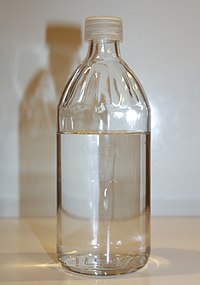
Photo from wikipedia
To make ionic liquids (ILs) accessible and economical, ethylene glycol was mixed in 1-ethyl-3-methylimidazolium-dicyanamide ([EMIm]DCA) to obtain droplets that could experimentally collide white fuming nitric acid. To investigate the ignition… Click to show full abstract
To make ionic liquids (ILs) accessible and economical, ethylene glycol was mixed in 1-ethyl-3-methylimidazolium-dicyanamide ([EMIm]DCA) to obtain droplets that could experimentally collide white fuming nitric acid. To investigate the ignition delay (ID) time theoretically in terms of hydrodynamics, alcohol fuels and kerosene were used as combustibles, while the intermiscibility between them and nitric acid (HNO3) was calculated using the ternary phase-field method alongside finite element analysis. The specific impulses of blend fuels were calculated by a thermodynamic method and compared to ILs. When the droplet was ethylene glycol/[EMIm]DCA with a 2.1 mm diameter and a 1.69 m/s colliding velocity, the ID time was the shortest. Kerosene was not an applicable additive for [EMIm]DCA owing to its lower intermiscibility with ILs and HNO3 than alcohol fuels; alcohol fuels, however, were appropriate. The concentration of ethylene glycol in the oxidizer pool increased faster than the concentration of propylene glycol, triggering more rapid hypergolic ignition in the first 50 ms. The protocols regarding the hypergolic ignition conditions were verified, i.e., the size of the droplet had to be minute when the colliding velocity was as fast as possible; this was carefully calculated using ethylene glycol. According to thermodynamic calculations, the addition of alcohol fuels can improve the specific impulse of fuels, with ethylene glycol performing the best. The feasibility of adding alcohol fuels to ILs was confirmed via experiments and thermodynamic computations, with the simulation results providing some guidance on selecting the experimental or engineering conditions or both.
Journal Title: ACS Omega
Year Published: 2022
Link to full text (if available)
Share on Social Media: Sign Up to like & get
recommendations!